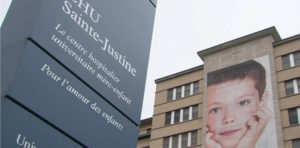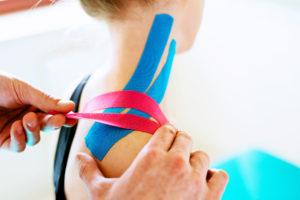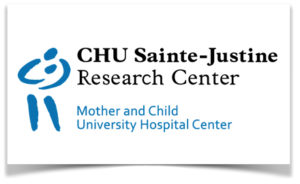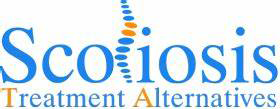Background on SpineCor
 The concept of a dynamic elastic tension orthosis, (the technical description of the SpineCor brace) was one of three scoliosis treatment innovations conceived by a team of 65 researchers that lead by two prominent orthopedic spine surgeons at the Research Centre in Sainte-Justine Children’s Hospital in Montreal Canada.
The concept of a dynamic elastic tension orthosis, (the technical description of the SpineCor brace) was one of three scoliosis treatment innovations conceived by a team of 65 researchers that lead by two prominent orthopedic spine surgeons at the Research Centre in Sainte-Justine Children’s Hospital in Montreal Canada.
The team was funded by the government of Quebec with $12.4 million dollars and they were tasked with studying the current scoliosis research literature to come up with new and improved treatment solutions for scoliosis, in order to create new innovative products that would advance the conservative and surgical treatment of scoliosis. The product that was developed to advance the conservative care of scoliosis was later named SpineCor.
The reason for this massive, publicly funded undertaking to develop new and improved scoliosis treatments was done was due to the fact the fact that although millions of children were diagnosed each year, the treatment options at the time were quite limited and in many cases not very effective in controlling the condition. As a result, doctors would often advise patients to simply “watch and wait” and essentially do nothing, rather than provide conservative treatment because they were very hard on the child and often had no beneficial outcome.
The orthopedists leading the study recognized that the most commonly prescribed conservative treatment for scoliosis was, and still is, hard bracing (aka – Static Bracing) had significant drawbacks that needed to be addressed.
Problems With A Static Scoliosis Brace
- Most hard braces are only designed to stop progression and not to improve scoliosis curves.
- The tendency for them to cause muscle atrophy, due to immobilization of the torso caused by the hard shell brace
- The tendency of them to also cause demineralization of the vertebra, due to de-weighting on the spine caused by the hard brace, which acts like an exoskeleton that transferring some of the body weight away from the spine when it is worn.
Since the muscle atrophy was caused by a lack of movement caused by the shell of the hard brace, they explored ways to create a brace that allowed for movement and also provided correction. To do this, they turned to the latest research on scoliosis treatment, particularly rehabilitation research.
Dynamic Solution To Static Brace Problem
What they came up with was, and still is truly revolutionary. The technical description of the device they came up with was a “dynamic tension orthosis” which was later named the The SpineCor Dynamic Scoliosis Brace.
 The design was based on the scoliosis research on a rehabilitation concept called Corrective Movement Therapy. This was the first and only truly dynamic scoliosis brace. It was a complete departure from the static orthopedic model of scoliosis bracing, which is designed to immobilize the spine, much like a body cast, in an attempt to keep the curvatures from progressing further.
The design was based on the scoliosis research on a rehabilitation concept called Corrective Movement Therapy. This was the first and only truly dynamic scoliosis brace. It was a complete departure from the static orthopedic model of scoliosis bracing, which is designed to immobilize the spine, much like a body cast, in an attempt to keep the curvatures from progressing further.
Unlike static braces, SpineCor was designed to move with the body, yet assisting it to repeatedly move into the direction of correction through the elastic recoil effects of the strategically positioned bands of the brace. Because this repetitive neuromuscular feedback, it helps create muscle memory strengthening the weakened muscles while it is worn throughout the day. This helps the body to establish new patterns of movement that are corrective that can improve the body’s posture, move it back towards mid-line and reduce the postural component of the scoliosis curvatures. At the time it was the only scoliosis brace that had been clinically proven to be able to reduce scoliosis curvatures and maintain the correction permanently, while hard braces can only, at best, stop further progression.

The principles that SpineCor works on are the same as those used in Kinesio-taping done for athletes to help rehabilitate them from injuries allowing them to safely return to their sport by providing the proper biomechanical support. The benefits provided to the injured athlete when elastic Kinesiotape is properly applied are improved posture and joint mechanics, improvements in nervous system feedback loops from the joints to the central nervous system and strengthening of the weakened muscles supporting the spine. In doing so, this also provides relief to other muscles that had been strained due to shifts in joint loads. This helps reduce inflammation caused by overuse of these muscles, reducing spasticity and relieve pain.
These are the same benefits SpineCor provides with its elastic bands, only SpineCor is a longer lasting solution. While kinesiotape applied to the body must be replaced every 2-4 days, SpineCor is designed to last for two years or more.
SpineCor – A Dynamic Scoliosis Brace Solution for Both Children & Adults
Initially, SpineCor was designed for adolescent idiopathic scoliosis, but since it was so successful in treating children, interest grew from our doctors for the treatment of adults with scoliosis. So in 2005, SpineCor started looking at ways they could modify the SpineCor brace for adult use. After completing their clinical trials in 2007, a second generation SpineCor brace was developed for adults called the SpineCor Pain Relief Brace for Adults.
While most teenage patients with scoliosis have no pain related to their curves, as they mature into adults many will develop pain related to the progression of the progression of their curves. Since orthopedists were even more reluctant to prescribe static bracing to adults, due to the issues of muscle atrophy, the SpineCor Pain Relief Brace quickly gained popularity among adults with scoliosis related pain. Since conventional medicine had very little to offer these patients, short of pain medication and scoliosis surgery, SpineCor has become the most commonly used scoliosis brace for adults. SpineCor’s Adult Pain Relief Brace helps interrupt the vicious cycle of scoliosis that causes pain and progression over the curves over time.
The vast majority of adults scoliosis patients who come to see us and are determined to be good candidates for SpineCor find that this dynamic treatment is able to relieve or significantly reduce their pain, improve their posture, move their body back towards midline to reduce the abnormal loading on the spine so that they can stop progression and avoid scoliosis surgery.
SpineCor Is SO Different, Should It Be Called a Scoliosis Brace?
The fact that the dynamic SpineCor design is such a departure from the conventional static brace that the developers initially considered not calling it a brace at all as it was more of a rehabilitative garment that is worn to strengthen and re-educate muscles in the torso to better support the spine. In this regard, SpineCor does the exact opposite of what a static brace does, it strengthens muscles rather than weakening them.
Ultimately the decision of placing SpineCor into the Scoliosis Brace category was one based on economics. The thinking was that if it was placed into the Scoliosis Brace category that the medical community and insurance carriers find it easier to understand and would be more inclined to provide reimbursement for it.
Why Is There Still Some Resistance In Some Of The Medical Community To SpineCor
While SpineCor is currently labeled as a scoliosis brace, this economic strategy somewhat backfired. Some insurance carriers decided that since it was such a complete departure from conventional static brace models that early on they would label it as “Experimental and Investigational” and unfortunately that label has stuck.
SpineCor’s One Of The Most Extensively Researched Scoliosis Braces
 The irony of this label is that SpineCor is one of the most thoroughly researched scoliosis brace designs on the market. In fact, it was developed at the Research Center affiliated with St. Justine Children’s Hospital in Montreal Canada, so it has been extensively studied with over 20 years of clinical research and studies behind it. In fact, as of 2012 over 1000 patients have been part of the long-term studies of the effectiveness of the dynamic SpineCor scoliosis brace.
The irony of this label is that SpineCor is one of the most thoroughly researched scoliosis brace designs on the market. In fact, it was developed at the Research Center affiliated with St. Justine Children’s Hospital in Montreal Canada, so it has been extensively studied with over 20 years of clinical research and studies behind it. In fact, as of 2012 over 1000 patients have been part of the long-term studies of the effectiveness of the dynamic SpineCor scoliosis brace.
Click Here To Read The Research Studies Done on SpineCor
Or


How much and where are these places to get it
Hello Joy,
We have 20 offices across the US so I would recommend that you Schedule a Free Phone Consult with the doctor in the office nearest you to find out if SpineCor is right for your scoliosis. If so, the doctor can discuss the cost and insurance considerations with you.
Dr. Brett Diaz, D.C.
Scoliosis Treatment Alternatives
Do you have a place in Austin Texas , also what is the cost, does insurance help cover some of it ?
Thank you 😊
April,
Yes, we do have an office in Austin. The best way to find out about costs is to first call and ask to schedule a Free Scoliosis Phone Consult with the doctor in that office and find out which of our services are right for your scoliosis. Then he can give you an estimate of the overall costs and discuss the insurance considerations.
please add me to your mailing list
Mary,
The best way for you to be added to our email list is for you to opt-in yourself.
Here is a link to a post on adult scoliosis treatment.
At the very bottom of this post you will see a yellow button. Click on that button and fill in your info and you will be added to our email list.
I am 76 and my scoliosis only manifested itself about five years ago. I would like to find out if I might be a candidate for this type of brace. My sister had surgery on her spine, with rods and spinal fusion. I do not want to do that. I still have flexibility, but a lot of pain.
The best way to find out is to schedule a Free Scoliosis Phone Consult with one of our doctors by clicking on the link above.
Can you email me this article and the research article so I can forward it to several friends who should contact you. Thanks you
Eillen,
It would be easier for you and better for them if you simply forwarded them this link. That way they could get additional treatment if they wanted on other pages of the site.
I am a healthy aged woman with dance background have genetic scoliosis need PT AND ADDITIONAL help to avoid chronic stooping willing to undertake new treatment I am quite flexible for my age and in good health, no pain attributed to my progressive scoliosis
Alice,
I’d recommend that you give us a call to schedule a Free Scoliosis Phone Consult to discuss your case with one of our doctors to find out if our treatments are right for you.
Dr. Diaz
I have a friend who has scololis. She does not have a computer so I will give her the information that you will send to my email address.
Thanks so much.
Joyce Johnson
Joyce,
You are a good friend. Thank you.
Dr. Brett Diaz, D.C.
Scoliosis Treatment Alternatives